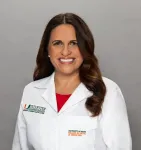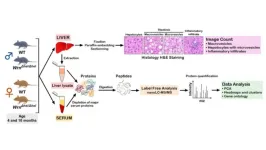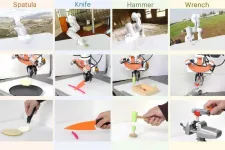(Press-News.org) MIAMI, FLORIDA (June 3, 2024) – Estelamari Rodriguez, M.D., M.P.H., is the recipient of the Patient Educator of the Year award from Cancer GRACE (Global Resource for Advancing Cancer Education). The award was presented May 31 in Chicago in recognition of Rodriguez’s work in breaking down language barriers around the world by creating Spanish-language educational content about lung cancer for patients and caregivers.
As a physician and a Latina, Rodriguez, a bilingual thoracic oncologist at Sylvester Comprehensive Cancer Center, part of the University of Miami Health System, has seen firsthand the ways that language barriers often prevent Spanish-speaking patients from receiving optimal care.
Since 2020, she has created Spanish-language video content and seminars for GRACE. She’s covered a wide range of lung cancer topics, including advances in targeted therapies and the newest research on biomarker testing, immunotherapy and emerging therapies. Her goal is to provide information that will help Spanish-speaking lung cancer patients communicate their concerns to health care providers and make better treatment decisions for themselves.
“It is a great honor to receive this award from the GRACE patient advocacy group,” Rodriguez said. “Educated patients are the best self-advocates.”
GRACE has presented the Patient Educator of the Year award annually since 2018. It recognizes an oncologist who has gone above and beyond in educating and empowering patients with cancer.
“We chose Dr. Rodriguez because she exemplifies our mission of providing accurate and reliable cancer education to patients and their advocates,” said GRACE Program Manager Maria Christian. “She tries to participate in our recorded video libraries and live events as often as possible, and if she's unable to work it into her schedule, then she will personally record a presentation on her own time and send it to GRACE for publication.”
A driving force in the multidisciplinary treatment of lung cancer
Rodriguez is a triple board-certified hematologist and oncologist who helped establish the multidisciplinary lung cancer care approach at Sylvester, South Florida’s only National Cancer Institute-designated center. The multidisciplinary approach incorporates clinicians from outside of oncology, creating a team that with patients from initial screening through diagnosis, treatment and support. Rodriguez is also a driving force behind Sylvester’s lung cancer screening program and has a particular interest in treating malignant mesothelioma. With a Sylvester at Aventura office location, she treats patients from both Miami-Dade and Broward counties.
Throughout her career, Rodriguez, who also holds a master’s degree in public health, has advocated for health equity. She is an active member of the ECOG/ACRIN Cancer Research Group Health Equity Committee and a mentor of the American Society of Clinical Oncology’s Virtual Diversity Mentoring Program for minority medical students and fellows. Her published research has included studying methods to reduce disparities in mesothelioma outcomes, particularly disparities related to social determinants of health, such as age, gender race and income.
The unique perspective of a Latina oncologist
Rodriguez uses her unique perspective as a Latina physician – only 2.4% of physicians in the U.S. are Latina – to improve outcomes and care for all of her patients.
“I have witnessed in my own family from Puerto Rico and in my medical training how our Spanish-speaking patients and caregivers are sometimes left out of the physician-patient conversation,” she said. “Many patients in our Latinx community are receiving suboptimal care because of lack of access and education about treatment options, risks and benefits and alternative treatments.”
Rodriguez also noted that caregivers and family members often play an integral role as members of the treatment team for Hispanic patients, which is why she makes an extra effort to speak to them, as well as to patients, in her videos and seminars.
GRACE’s Christian praised the quality of Rodriguez’s content and her understanding of how to communicate to overwhelmed caregivers and patients – by being factual, professional and personable. Christian also underscored the importance of Rodriguez’s Spanish-language material, which, she noted, reaches “a vulnerable population that too often find a lack of materials when searching for information.”
about Sylvester research on the InventUM Blog and follow @SylvesterCancer on X for the latest news on its research and care.
# # #
END
Even as classrooms, offices, concerts and weddings have begun to look more like their pre-2020 counterparts, marks of the global pandemic remain visible in new norms and long-term issues.
“COVID-19 affected a whole generation of individuals at every level,” said Khalid Afzal, MD, a pediatric psychiatrist at the University of Chicago Medicine.
In conversations on social media and in other forums, many people share a general sense that COVID-19 had a significant impact on mental health — that it represents a collective trauma from which we will be healing for years. Now that researchers have a few years’ worth of data to analyze, they’re beginning to unpack that ...
FOR IMMEDIATE RELEASE
Monday, June 3, 2024
Contact:
Jillian McKoy, jpmckoy@bu.edu
Michael Saunders, msaunder@bu.edu
##
Researchers: Excluding Partisanship Questions from Public Health Surveys ‘Limits Our Capacity for Advancing Population Health and Health Equity’
A new commentary in the American Journal of Public Health urges public health researchers to incorporate questions about partisan identity in demographic data collection, arguing that excluding this information could lead to ineffective policy and health promotion interventions.
The partisan divide in attitudes toward vaccination and masking during the COVID-19 pandemic made clear that ...
In disease research, it’s important to know gene expression and where in a tissue the expression is happening, but marrying the two sets of information can be challenging.
“Single-cell technologies, especially in the emerging field of spatial transcriptomics, help scientists see where in a tissue the genes are turned on or off. It combines information about gene activity with the exact locations within the disease tissues,” explains Fan Zhang, PhD, assistant professor of medicine with a secondary appointment ...
Embargoed for release until 5:00 p.m. ET on Monday 3 June 2024
Annals of Internal Medicine Tip Sheet
@Annalsofim
Below please find summaries of new articles that will be published in the next issue of Annals of Internal Medicine. The summaries are not intended to substitute for the full articles as a source of information. This information is under strict embargo and by taking it into possession, media representatives are committing to the terms of the embargo not only on their ...
ACP Recommends AI Tech Should Augment Physician Decision-Making, Not Replace It
WASHINGTON, June 4, 2024—The use of artificial intelligence (AI) in clinical health care has the potential to transform health care delivery but it should not replace physician decision-making, says the American College of Physicians (ACP) in a new policy paper published today. “Artificial Intelligence in the Provision of Health Care,” published in the Annals of Internal Medicine, offers recommendations on the ethical, scientific, and clinical components of ...
New Haven, Conn. — A new scientific model is giving researchers an unprecedented, global look at the activities of clams, worms, and other invertebrate animals that burrow at the bottom of the ocean.
And what they find may offer new insights into how these mud-churning species affect ocean chemistry, carbon sequestration, and the ability of marine life to thrive globally.
Scientists have long debated the role of “bioturbation” — the excavation and stirring up of seafloor sediments caused by these species. Part of the challenge has come from trying to understand how the interactions between these animals and their surroundings influence bioturbation patterns ...
An article published in the journal Insects determines with precision the dispersal range of a type of wasp that neutralizes the Brown stink bug, Euschistus heros, a major soybean pest in Brazil and highly resistant to chemical insecticides. The solution discussed by the authors is Telenomus podisi, a parasitoid micro wasp first described by American entomologist William Harris Ashmead in 1893.
Parasitoids are small insects whose immature stages develop either within or attached to the outside of other insects. They ...
Rutgers University–New Brunswick researchers conducting a study at a high-traffic intersection in a Jersey Shore town have found that the installation of a bike lane along the road approaching the convergence reduced driving speeds.
As many traffic analyses have identified speeding as a contributing factor in a majority of crashes, inducing such a “traffic calming” effect with a bike lane could enhance road safety and decrease the risk and severity of crashes, the researchers said. The research was published in The Journal of Urban Mobility.
“We are giving you more evidence that bike lanes save lives,” said Hannah Younes, a lead author of the study and a postdoctoral ...
“Proteomics analysis at different ages allows us to follow the progressive biological alterations (including histological fat accumulation) in the liver according to age and/or the Wrn genotype.”
BUFFALO, NY- June 3, 2024 – A new research paper was published on the cover of Aging (listed by MEDLINE/PubMed as "Aging (Albany NY)" and "Aging-US" by Web of Science) Volume 16, Issue 10, entitled, “Integrated liver and serum proteomics uncover sexual dimorphism and alteration of several immune response proteins in an aging Werner syndrome mouse model.”
Werner syndrome (WS) is a ...
CAMBRIDGE, MA – Let’s say you want to train a robot so it understands how to use tools and can then quickly learn to make repairs around your house with a hammer, wrench, and screwdriver. To do that, you would need an enormous amount of data demonstrating tool use.
Existing robotic datasets vary widely in modality — some include color images while others are composed of tactile imprints, for instance. Data could also be collected in different domains, like simulation or human demos. And each dataset ...


